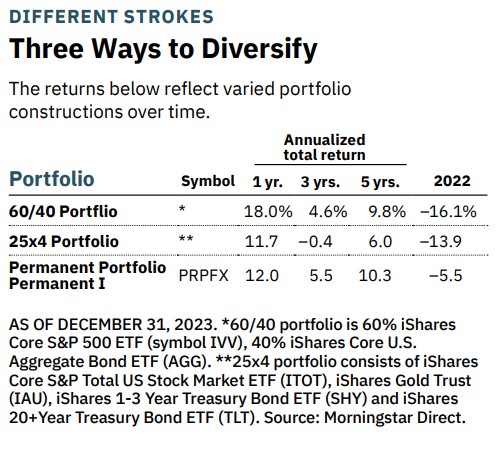Should You Use a 25x4 Portfolio Allocation?
The 25x4 portfolio is supposed to be the new 60/40. Should you bite?


After a disastrous market in 2022, many strategists claimed that the 60/40 portfolio, which holds 60% of assets in stocks and 40% in bonds, was dead. In its place, some strategists suggested investors consider the 25/25/25/25 portfolio, or 25x4 portfolio, which calls for dividing your assets evenly into stocks, bonds, commodities and cash.
"We believe the 25/25/25/25 portfolio will outperform the 60/40 portfolio in the 2020s," says Michael Hartnett, a chief investment strategist at BofA Global Research.
The simplest reason is that interest rates and inflation are higher than in decades past. The 60/40 portfolio worked best when inflation and interest rates were low or falling, says Hartnett. But this decade he expects higher inflation and interest rates, with added volatility, creating market conditions that are well suited for cash and commodities to outperform bonds and stocks.
From just $107.88 $24.99 for Kiplinger Personal Finance
Become a smarter, better informed investor. Subscribe from just $107.88 $24.99, plus get up to 4 Special Issues

Sign up for Kiplinger’s Free Newsletters
Profit and prosper with the best of expert advice on investing, taxes, retirement, personal finance and more - straight to your e-mail.
Profit and prosper with the best of expert advice - straight to your e-mail.
So far, though, that hasn't played out. Although the 25x4 portfolio did marginally better than a 60/40 portfolio in 2022, over longer periods, it has lagged. A 60/40 portfolio has gained 4.6% annualized over the past three years; a 25x4 portfolio has lost 0.4% on average per year.
Think twice before switching to the 25x4 portfolio
In short, don't count the 60/40 portfolio out yet. "Over the years, the 60/40 portfolio has held up for investors, and it's actually provided wonderful returns with low risk levels," says Jan Holman, director of adviser education at Thornburg Investment Management.
This isn't the first go-around for the 25x4 portfolio. It got its start decades ago by way of Harry Browne, the late investment adviser and two-time Libertarian Party presidential candidate (in 1996 and 2000). In Browne's so-called Permanent Portfolio strategy, investors held 25% in cash, 25% in gold, 25% in long-term bonds and 25% in stocks, rebalancing annually. The idea was that the four asset classes would help minimize risk no matter the market or economic condition.
Browne helped develop a no-load mutual fund tied to the 25x4 strategy called the Permanent Portfolio Permanent (PRPFX), which launched in 1982. But it's not a straight-up version of his approach. Instead, the fund is more "dynamic," says fund manager Michael Cuggino.
It targets an allocation of 30% stocks, 25% precious metals (20% in gold and 5% in silver) and 45% in bonds and cash (10% of which is denominated in Swiss Francs). The stock side of the portfolio includes a mix of real estate and natural-resources stocks, such as Prologis (PLD) and Exxon Mobil (XOM), as well as aggressive growth stocks, such as Nvidia (NVDA) and Meta Platforms (META). "The fund's goal is to outpace inflation," says Cuggino, a fund manager since 2003.
The fund's annualized 5.7% return over the past decade has indeed beaten the 2% average inflation rate over the period. And it has been far less volatile over that time than its peers (moderate allocation funds), which typically hold about 60% of assets in stocks. But 63% of its peers did better, generating an average 6.1% annualized 10-year return.
That's evidence that it's important to think through any allocation strategy carefully before you implement it. "Asset allocation should always be decided on an individual basis and in the context of a comprehensive financial plan, not based on a gimmick," says Gordon Achtermann, a certified financial planner in Fairfax, Virginia. As an alternative, consider a low-cost target-date fund. "You won't beat the market," he says, "but you won't get badly hurt, either."

Note: This item first appeared in Kiplinger's Personal Finance Magazine, a monthly, trustworthy source of advice and guidance. Subscribe to help you make more money and keep more of the money you make here.
Related content
Profit and prosper with the best of Kiplinger's advice on investing, taxes, retirement, personal finance and much more. Delivered daily. Enter your email in the box and click Sign Me Up.

Nellie joined Kiplinger in August 2011 after a seven-year stint in Hong Kong. There, she worked for the Wall Street Journal Asia, where as lifestyle editor, she launched and edited Scene Asia, an online guide to food, wine, entertainment and the arts in Asia. Prior to that, she was an editor at Weekend Journal, the Friday lifestyle section of the Wall Street Journal Asia. Kiplinger isn't Nellie's first foray into personal finance: She has also worked at SmartMoney (rising from fact-checker to senior writer), and she was a senior editor at Money.
-
 I'm want to give my 3 grandkids $5K each for Christmas.
I'm want to give my 3 grandkids $5K each for Christmas.You're comfortably retired and want to give your grandkids a big Christmas check, but their parents are worried they might spend it all. We ask the pros for help.
-
 If You're Not Doing Roth Conversions, You Need to Read This
If You're Not Doing Roth Conversions, You Need to Read ThisRoth conversions and other Roth strategies can be complex, but don't dismiss these tax planning tools outright. They could really work for you and your heirs.
-
 Could Traditional Retirement Expectations Be Killing Us?
Could Traditional Retirement Expectations Be Killing Us?A retirement psychologist makes the case: A fulfilling retirement begins with a blueprint for living, rather than simply the accumulation of a large nest egg.
-
 AI Stocks Lead Nasdaq's 398-Point Nosedive: Stock Market Today
AI Stocks Lead Nasdaq's 398-Point Nosedive: Stock Market TodayThe major stock market indexes do not yet reflect the bullish tendencies of sector rotation and broadening participation.
-
 Dow Adds 646 Points, Hits New Highs: Stock Market Today
Dow Adds 646 Points, Hits New Highs: Stock Market TodayIt was "boom" for the Dow but "bust" for the Nasdaq following a December Fed meeting that was less hawkish than expected.
-
 Dow Rises 497 Points on December Rate Cut: Stock Market Today
Dow Rises 497 Points on December Rate Cut: Stock Market TodayThe basic questions for market participants and policymakers remain the same after a widely expected Fed rate cut.
-
 JPMorgan's Drop Drags on the Dow: Stock Market Today
JPMorgan's Drop Drags on the Dow: Stock Market TodaySmall-cap stocks outperformed Tuesday on expectations that the Fed will cut interest rates on Wednesday.
-
 Crypto Trends to Watch in 2026
Crypto Trends to Watch in 2026Cryptocurrency is still less than 20 years old, but it remains a fast-moving (and also maturing) market. Here are the crypto trends to watch for in 2026.
-
 Small Caps Hit a New High on Rate-Cut Hope: Stock Market Today
Small Caps Hit a New High on Rate-Cut Hope: Stock Market TodayOdds for a December rate cut remain high after the latest batch of jobs data, which helped the Russell 2000 outperform today.
-
 What Investors May Face in the New Year: Interview
What Investors May Face in the New Year: InterviewKeith Lerner, the chief market strategist and chief investment officer for Truist Wealth, speaks with Kiplinger.
-
 UNH Sparks a 408-Point Surge for the Dow: Stock Market Today
UNH Sparks a 408-Point Surge for the Dow: Stock Market TodayThe best available data right now confirm both a slowing employment market and a December rate cut, a tension reflected at the equity index level.